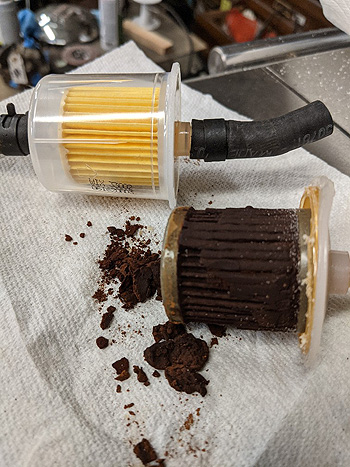Fuel system rust
by Phil Lapin / CPPC Tech Committee and President
I have now gone through the process of replacing all of my fuel system components, and I think it worthwhile to describe what has transpired.
 When I acquired our 1942 Plymouth it had been sitting for over 30 years. Even though (supposedly) under a shed roof, moisture and temperature changes take their toll. This is especially true as related to the various parts of a fuel system. The gas tank had been removed prior to my acquiring the car, mechically cleaned internally and then re-installed. A new fuel pump had also been fitted. What remained untouched were the actual fuel line pieces, as well as the float bowl in the carburetor. That was where I began when restoring the car.
When I acquired our 1942 Plymouth it had been sitting for over 30 years. Even though (supposedly) under a shed roof, moisture and temperature changes take their toll. This is especially true as related to the various parts of a fuel system. The gas tank had been removed prior to my acquiring the car, mechically cleaned internally and then re-installed. A new fuel pump had also been fitted. What remained untouched were the actual fuel line pieces, as well as the float bowl in the carburetor. That was where I began when restoring the car.
The first odd thing we found was that the engine would not continue to run after priming and starting it. Disconecting the fuel line at the carb and blowing into it – one could hear bubbling in the fuel tank. The assumption was that the line was open. What was really happening was that junk in the fuel line at some fitting point was blowing backwards as the tube was blown into, and then moving back into a blocked position when there was a fuel pump draw upon the line.
I removed all of the old fuel line as a starter. It literally broke into several pieces as I bent it to remove it. The steel had almost rusted through from both the outside and inside. New lines and fittings were installed from back to front. In this process, I put an in-line disposable filter just before the carburetor. Then I began working on various other parts of the car – which took about 3 years off an on. The engine was started a few times during that period, probably running 2 or 3 hours total.
The day finally arrived late last year to road test the car. It started OK, and ran fine at "neighborhood speeds" of about 35 mph. Then came the highway test – from Sandy OR down to Troutdale and back on Hwy 26. There is a good grade along that route. Going up the grade, I suddenly experienced violent bucking and hesitation with no ability to accelerate well. What now? I took a couple of more runs with increasingly bad results – so I limped back to the garage.
At this point, the car had been run no more than 40-50 miles since I had acquired it. Upon investigating, I found about ¼ inch of fine sediment in the glass fuel pump bowl. Moving along the line, I noticed that the disposible filter looked clogged. The attached picture shows what I found when I cut it apart – a complete caking of fine rust "powder" preventing fuel flow. Then I opened the carb and found sludge in the bottom of the bowl. A huge mess – and the ONLY place it could have come from was the fuel tank itself. Removing the fuel gauge sender from the tank and peeking in, sure enough there was loose rust all over the bottom. So – I dropped the tank and bought a new one for around $300. I should have done that at the very first. I am convinced that any form of cleaning of a rusty tank only removes the big obvious pieces. Fine particles continue to fall away from the internal metal, causing an amazingly rapid buildup and plugging of a good filter.
So my recommendation is – save yourself a lot of headaches and replace everything in your fuel system. I now have power to spare and great acceleration in the 1942 Plymouth. What a pleasure


